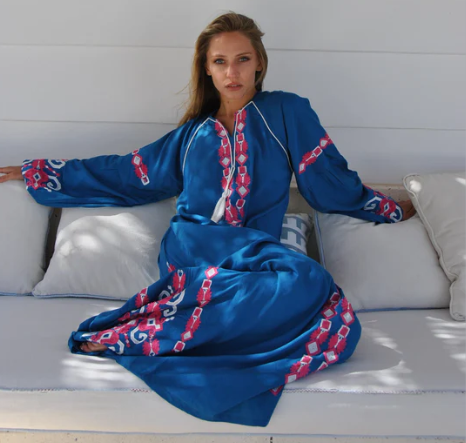The basic kaftan dress is styled as long-sleeved, ankle-length robe or tunic that closes or
buttons in the front. This simple style, however, hides the long and versatile history of the
kaftan, and its multitudinous styles and variations through multiple different cultures.
In the recent decades gone by, the kaftan has become very popular in Western countries,
mainly as a woman’s fashion. The kaftan dress attracts all tastes as it is uncomplicated, all-
purpose and can add a touch of the traditional or the exotic into a wardrobe.
Classic Kaftan To Traditional Styles
The classic kaftan makes for an attractive house dress with open, billowing sleeves and a
high collar. Although the modern variations feature V-neck collars or other cuts. Some
traditional designs have tighter, narrower sleeves. Different varieties may be found from
region to region.
Buttons or ties are found on the front of the outfit from the neck to the waist, except on pull-
over designs. A sash or a tunic is sported along the waist to lend a bit of shape to the
otherwise freely flowing tunic.
The traditional style ends up at the ankles. Although modern styles may be shorter, and
kaftan-inspired tunics are occasionally worn as shirts or blouses. A sweater, cloak or loose
outer jacket completes the traditional kaftan.
Kaftan’s Adaptability Is A Virtue
An outstanding feature of this classic garment is adaptability to changing weather conditions.
Loose kaftan is a house dress made of lighter materials that makes for an ideal outfit for hot
climates. Although heavier variants are suited for cooler conditions. Kaftan is a loose dress
that can be worn over undergarments. But has the adaptability to wear under heavy
outerwear.
It may be held close to the body at the waist or made looser for coolness. The buttons or ties
can be kept buttoned to varying heights according to temperature. The kaftan was and still is
an all-purpose, everyday garment for year-round wear in its countries of origin.
Kaftan’s Adoption To Contemporary Fashion
The kaftan’s virtue of being a versatile, all-purpose garment ensured its adoption by
contemporary fashion. It can be worn long or short, tied, or loose. Also, cut or worn to flatter
any body shape. Kaftans as garments are most conformable to any situation or lifestyle.
Designers often create tops in a kaftan style with billowing sleeves and V-Necks for daily
wear. Full-length kaftans may be worn to act as cover-ups for the beach or pool. Wearers are
allowed to accessorize their kaftan dresses along traditional lines. For instance, with a sash,
belt, or outer coat. Alternatively, they may adapt it for their existing wardrobe.
The Summary
The kaftan burst into the fashions of Europe and North America in the 1960s among a
growing interest in Middle Eastern cultures. In the United States, the hippy subculture
embraced the kaftan. Moreover, the dashiki, inspired by West African kaftan-style garments,
became popular in the African American community. Today, the kaftan dress has turned into
a staple of women’s Islamic fashion, either in its original form or through kaftan-inspired
designs. The kaftan is a versatile and functional garment adapted by cultures across a wide
geographic area.




